The decision to move to a senior living community is like choosing a college. But unlike college, you might live at a senior living community for a decade. This chapter should be one of promise and hope for a vibrant future. Finding the right community for your needs can imbue you with a new sense of hope and a plan for the next stage of your life. You have many good choices, but the key lies in choosing the right community for you.
It’s not enough to just read marketing materials and tour communities. After all, this information is designed to present senior living communities in the best light possible. By taking a proactive stance to ask about the issues that concern you most, you increase the likelihood that you’ll find the perfect fit.
Download The Complete Guide to Choosing Between Senior Living Options
This is a big decision. The right community opens new doors to growth and connection while providing a safe space to live out your golden years. You deserve as much information as you need to make the decision. No question should feel too big or too small, and you shouldn’t be shy about your queries. People who ask better questions get more answers, which arm you with the information you need to make the best possible decision.
1. What Are the Accommodations Like?
This cuts to the heart of the hunt for a senior living community. Ask about the living quarters, how much privacy you can expect, what personal effects you can bring, whether any items are forbidden on the grounds, and when you can have visitors. If you need medical assistance, be sure to inquire about the level of assistance available and how frequently you can anticipate being checked on.
Most communities offer a wide range of living arrangements in various sizes, layouts, and locations, from apartments located in the hub of community action to quieter homes on upper floors or ends of hallways. Consider where you’ll be happiest and in what kind of floor plan. Then ask to see an apartment similar to the one you might live in. Picture your possessions in the home. Can the staff provide a floor plan with measurements so you have an idea of what can fit?
Additionally, ask which utilities—cable, internet, emergency call systems, etc.—are included in the rent. You may also want to know about Wi-Fi availability and Wi-Fi speed if having reliable internet is important to you. For example, will you be sharing Wi-Fi with the rest of the community and visitors, or will you, your section, or your floor have a dedicated network?
2. What Activities Are Available?
Seniors often choose senior living communities because they feel increasingly isolated in their own homes. Some seniors may be unable to drive, while others find that health concerns keep them at home. The switch to a new community offers new opportunities to learn, socialize, and play. Ask what activities are available and any eligibility requirements. Some communities also offer transportation to local senior centers or other outside events, so inquire about these options as well.
3. What Do You Do to Keep Residents Safe?
For most older adults contemplating life at a senior living community, safety issues figure prominently. Ask what the community does to ensure your safety. Think about posing questions like:
- Do residents have access to alert buttons for emergency assistance? Do these buttons provide the resident’s location so that staff can easily locate them?
- Does the apartment have pull cords?
- What about bathing safety? Are there rails or easy-entry bathtubs? Are there grab bars and non-slip surfaces installed?
- How does the community handle medical emergencies? What about at night? Is staff available 24/7?
- What system is in place to ensure residents are present and accounted for?
- Is there an emergency response plan? Does the community perform fire or other safety drills?
- Is there a generator for backup power?
- What background checks does the community perform on staff?
- Can residents request nightly safety checks or other regular visits?
4. What Can a Resident Do If They Have a Complaint?
No community is perfect; however, excellent ones are committed to great care and continual improvements in service. They have an open door policy, actively soliciting to and addressing feedback from families, residents, and staff. Ask how the community manages concerns. The first stage should be to contact the community’s leadership team, and from there, an option to reach out to management or ownership. Inquire about a feedback loop, and whether there is a policy for managing complaints or concerns. Quality communities are transparent and facilitate excellent communication between families, staff, and residents.
5. Can We Talk to References?
Any good community has a long list of glowing reviews. Ask if you can talk to some residents or their families to get a feel for what life at the community is really like.
6. Is Transportation Available?
There’s a whole world outside of your community, and it’s important to remain connected to it. Ask about the community’s transportation options. Most communities offer transportation within a defined radius, often via a regular shuttle service. The community may also have predetermined transportation days for doctor’s visits, religious services, and other necessities. Consider the places you want to visit, and ask whether they’re part of the transportation route. There may also be transportation to scheduled outings, such as restaurants, museums, theaters, and more. Be sure to ask whether or not you can request additional transportation as needed and any associated fees.
7. What Training and Qualifications Do Staff Have?
Excellent staff are the heart of an excellent community. Ask about the specific training and qualifications of staff at every level. What medical providers are available? What experience and training do they have? Who will be interacting with and caring for you on a daily basis? How many hours of training do staff receive, and what sort of continuing education must they complete? Are there monthly or other regular meetings to strengthen skills and address concerns?
8. What Are the Food Options Like?
Seniors are more interested in delicious and healthy food than ever before. A generation ago, senior living communities offered meals at set times. Everyone ate the same food together, often in assigned seats. That has changed significantly. Many communities now offer all-day dining services at multiple venues, including formal dining centers, pubs, and cafes. The more meal options that are available, the more likely it is you’ll find something delicious and healthy that you enjoy.
Good nutrition is a key ingredient in the recipe for good health, and that means palatable and healthy food options should be available. If you have special dietary needs, such as vegetarian or low sodium, ask how the community accommodates these needs. The food preparation team should regularly consult with a nutritionist and should be prepared to work with your doctor to meet your nutritional goals.
9. What Is the Continuum of Available Medical Care?
Most older adults looking into senior living communities need, or will need, medical care on an ongoing basis. Ask questions specific to your medical needs. For instance, you may want to ask how the community supports residents’ physical, cognitive and emotional needs and what types of therapy and services as available.
You’ll also need to plan for the continuum of care you may need in the future. Some good starting questions include:
- What conditions can this community manage? Are there any it is not equipped to manage?
- Will I need to move to another location in the community if my needs change?
- Can you help with medication management?
- What daily needs can you help me with?
- Can your community help me get medical help if my needs change? Will you be monitoring for changes in the condition of residents?
- Can I keep my prescription and over-the-counter medications in my room, or must someone else administer them
10. How Much Will It Cost?
Most people learn early that it’s rude to talk about money. You might feel like you’re being stingy or cheap by asking specific, direct financial questions. But finances are a major factor in your decision. After you’ve taken a tour and decided that a community is on your list of top choices, get a clear cost breakdown. Some questions to consider:
- What is the base price per month or year?
- How are costs paid, and will they change over time?
- What is the cost for the amenities and living arrangements I saw on my tour?
- What specific amenities are included in the base price? Regular visits with staff? Laundry? Meals? What add-ons do I have to pay for and at what cost?
11. How Does This Community Collaborate and Communicate with Families and Residents?
We live in an era of lightning-fast communication. Ask what the community does to ensure you and your family know about upcoming changes at the community. Is there a Facebook page? A weekly or monthly newsletter? An email list? A community message or discussion board? How are official communications provided, and does the community take into account resident feedback? Is there a resident leadership or advisory board? It’s a big red flag if communication runs only one way, with residents learning about changes only after they have happened.
What about the transition to the community? Is there a welcoming committee? What about a resident orientation?
Particularly for seniors who have evolving or complex medical needs, fostering communication between the senior, their family, and their medical team is vital for good health and peace of mind. Ensure you can designate an authorized family representative to receive information about your medical care. Excellent communities have a clear communication plan in place for medical emergencies and changes. For example, if the facility is concerned that you’re not caring for yourself or that you might need a consultation with a specialist, they should know who in your family to call.
Don’t Be Afraid to Ask Tough Questions
People who ask lots of questions get better medical care. The same principle extends to the search for senior living communities. By asserting your needs and asking whether a community is equipped to meet them, you can steadily narrow down the list of options. There’s no perfect senior living community; however, there is a perfect senior living community for you.




